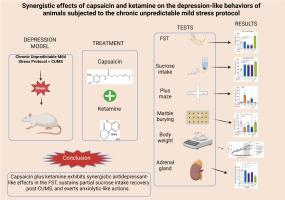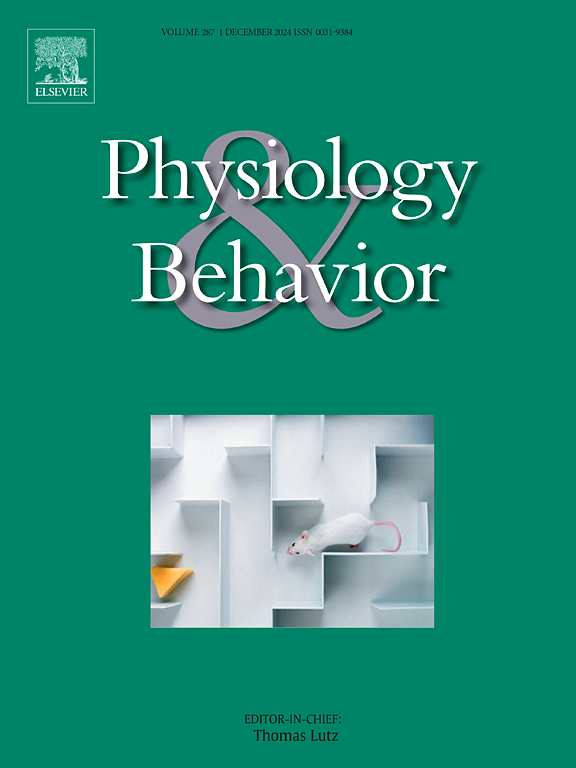Synergistic effects of capsaicin and ketamine on the depression-like behaviors of animals subjected to the chronic unpredictable mild stress protocol
IF 2.5
3区 医学
Q2 BEHAVIORAL SCIENCES
引用次数: 0
Abstract
A significant percentage of depression patients are resistant to pharmacological treatments, highlighting the need for novel antidepressant strategies. Ketamine, an NMDA receptor antagonist, produces rapid antidepressant effects and is effective in treatment-resistant cases, but its association with cognitive and behavioral abnormalities resembling schizophrenia limits broader clinical utility. Capsaicin, a TRPV1 agonist, alone or combined with standard antidepressants, reduces immobility in the forced swim test (FST) in rodents. This study evaluated the effects of capsaicin and ketamine, isolated or combined treatments, in the chronic unpredictable mild stress (CUMS) model using multiple behavioral tests. We found immediate (day 1) and sustained (day 6) synergistic effects of capsaicin and ketamine in the FST after CUMS. The sucrose preference test (SPT) was performed on similar schedule. None of the treatments increased SPT on the last day of CUMS; however, capsaicin, ketamine, and their combination significantly increased SPT on day 6 post-CUMS, though pharmacologically treated groups did not reach SPT values of non-CUMS rats. Capsaicin alone and in combination with ketamine produced anxiolytic-like effects in the elevated plus maze and marble-burying tests. Locomotor activity in the open field test was unaffected by treatments, but all CUMS-exposed groups showed higher activity than non-CUMS animals. The most effective doses of capsaicin or the combination improved body weight and reduced adrenal gland hypertrophy, yet not to non-CUMS levels. These findings indicate that capsaicin plus ketamine exhibits synergistic antidepressant-like effects in the FST, sustains partial SPT recovery post-CUMS, and exerts anxiolytic-like actions.

辣椒素和氯胺酮对慢性不可预测轻度应激动物抑郁样行为的协同作用。
很大比例的抑郁症患者对药物治疗有抵抗力,这突出了对新型抗抑郁药物策略的需求。氯胺酮是一种NMDA受体拮抗剂,能产生快速的抗抑郁作用,对治疗难耐的病例有效,但它与类似精神分裂症的认知和行为异常的关联限制了更广泛的临床应用。辣椒素是一种TRPV1激动剂,单独使用或与标准抗抑郁药联合使用,可减少啮齿类动物强迫游泳试验(FST)中的不动。本研究通过多种行为测试评估辣椒素和氯胺酮单独或联合治疗在慢性不可预测轻度应激(CUMS)模型中的效果。我们发现辣椒素和氯胺酮在CUMS后的FST中立即(第1天)和持续(第6天)产生协同效应。蔗糖偏好试验(SPT)按相同的程序进行。在CUMS的最后一天,所有处理都没有增加SPT;然而,辣椒素、氯胺酮及其联合使用显著增加了cums后第6天的SPT,尽管药物治疗组未达到非cums大鼠的SPT值。辣椒素单用和氯胺酮联用在升高加迷宫和大理石掩埋试验中产生抗焦虑样作用。在野外试验中,运动活动不受治疗影响,但所有暴露于cums的组都比未暴露的动物表现出更高的活动。辣椒素的最有效剂量或组合改善体重和减少肾上腺肥大,但没有达到非cums水平。这些发现表明,辣椒素加氯胺酮在FST中表现出协同抗抑郁样作用,在cums后维持部分SPT恢复,并发挥抗焦虑样作用。
本文章由计算机程序翻译,如有差异,请以英文原文为准。
求助全文
约1分钟内获得全文
求助全文
来源期刊

Physiology & Behavior
医学-行为科学
CiteScore
5.70
自引率
3.40%
发文量
274
审稿时长
47 days
期刊介绍:
Physiology & Behavior is aimed at the causal physiological mechanisms of behavior and its modulation by environmental factors. The journal invites original reports in the broad area of behavioral and cognitive neuroscience, in which at least one variable is physiological and the primary emphasis and theoretical context are behavioral. The range of subjects includes behavioral neuroendocrinology, psychoneuroimmunology, learning and memory, ingestion, social behavior, and studies related to the mechanisms of psychopathology. Contemporary reviews and theoretical articles are welcomed and the Editors invite such proposals from interested authors.
 求助内容:
求助内容: 应助结果提醒方式:
应助结果提醒方式:


